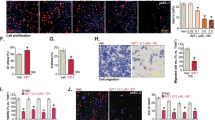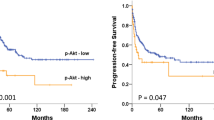Abstract
We have investigated the interrelationship between two anti-apoptotic factors, XIAP and Akt, and their role in chemoresistance of uterine cancer cells. We used one cervical cancer cell line (HeLa) and two endometrial cancer cell lines (KLE and Ishikawa) as a model. The three drugs decreased Akt and XIAP content and induced apoptosis in P-Akt-negative HeLa cells. In P-Akt1/3-positive Ishikawa cells apoptosis induction correlated with XIAP decrease. P-Akt1/2/3-positive KLE cells showed maximum chemoresistance as XIAP and Akt levels/phosphorylation remained stable in response to the three drugs, and only cisplatin could significantly induce apoptosis. We found that XIAP and Akt were functionally linked in uterine cancer cells, as downregulation of XIAP with RNAi decreased P-Akt levels, and inhibition of PI3-K/Akt activity using LY294002 decreased XIAP content. Overexpression of constitutively active Akt isoforms in HeLa cells induced isoform-specific sensitivity to doxorubicin and taxol but not cisplatin. XIAP RNAi increased the cell-specific sensitivity to cisplatin and doxorubicin but not taxol. Finally, we found P-Akt immunoreactivity in epithelial cells from multiple human endometrial carcinoma tumors, suggesting that Akt may also regulate chemosensitivity in uterine cancers in vivo. Altogether these results highlight an intertwined role for specific Akt isoforms and XIAP in chemoresistance of uterine cancer cells.







Similar content being viewed by others
References
Arends MJ, Wyllie AH (1991) Apoptosis: mechanisms and roles in pathology. Int Rev Exp Pathol 32:223–254
Nakatani K, Sakaue H, Thompson DA, Weigel RJ, Roth RA (1999) Identification of a human Akt3 (protein kinase B gamma) which contains the regulatory serine phosphorylation site. Biochem Biophys Res Commun 257:906–910
Coffer PJ, Woodgett JR (1991) Molecular cloning and characterisation of a novel putative protein-serine kinase related to the cAMP-dependent and protein kinase C families. Eur J Biochem 201:475–481
Jones PF, Jakubowicz T, Pitossi FJ, Maurer F, Hemmings BA (1991) Molecular cloning and identification of a serine/threonine protein kinase of the second-messenger subfamily. Proc Natl Acad Sci U S A 88:4171–4175
Bellacosa A, Testa JR, Staal SP, Tsichlis PN (1991) A retroviral oncogene, akt, encoding a serine-threonine kinase containing an SH2-like region. Science 254:274–277
Cheng JQ, Godwin AK, Bellacosa A et al (1992) AKT2, a putative oncogene encoding a member of a subfamily of protein-serine/threonine kinases, is amplified in human ovarian carcinomas. Proc Natl Acad Sci USA 89:9267–9271
Datta SR, Brunet A, Greenberg ME (1999) Cellular survival: a play in three Akts. Genes Dev 13:2905–2927
Cho H, Mu J, Kim JK et al (2001) Insulin resistance and a diabetes mellitus-like syndrome in mice lacking the protein kinase Akt2 (PKB beta). Science 292:1728–1731
Cho H, Thorvaldsen JL, Chu Q, Feng F, Birnbaum MJ (2001) Akt1/PKBalpha is required for normal growth but dispensable for maintenance of glucose homeostasis in mice. The journal of biological chemistry 276:38349–38352
Chen WS, Xu PZ, Gottlob K et al (2001) Growth retardation and increased apoptosis in mice with homozygous disruption of the Akt1 gene. Genes Dev 15:2203–2208
Easton RM, Cho H, Roovers K et al (2005) Role for Akt3/protein kinase Bgamma in attainment of normal brain size. Mol Cell Biol 25:1869–1878
Gagnon V, Mathieu I, Sexton E, Leblanc K, Asselin E (2004) AKT involvement in cisplatin chemoresistance of human uterine cancer cells. Gynecol Oncol 94:785–795
Uren AG, Pakusch M, Hawkins CJ, Puls KL, Vaux DL (1996) Cloning and expression of apoptosis inhibitory protein homologs that function to inhibit apoptosis and/or bind tumor necrosis factor receptor-associated factors. Proc Natl Acad Sci USA 93:4974–4978
Takahashi R, Deveraux Q, Tamm I et al (1998) A single BIR domain of XIAP sufficient for inhibiting caspases. J Biol Chem 273:7787–7790
Deveraux QL, Roy N, Stennicke HR et al (1998) IAPs block apoptotic events induced by caspase-8 and cytochrome c by direct inhibition of distinct caspases. EMBO J 17:2215–2223
Deveraux QL, Leo E, Stennicke HR, Welsh K, Salvesen GS, Reed JC (1999) Cleavage of human inhibitor of apoptosis protein XIAP results in fragments with distinct specificities for caspases. EMBO J 18:5242–5251
Van Themsche C, Mathieu I, Parent S, Asselin E (2007) Transforming growth factor-beta3 increases the invasiveness of endometrial carcinoma cells through phosphatidylinositol 3-kinase-dependent up-regulation of X-linked inhibitor of apoptosis and protein kinase c-dependent induction of matrix metalloproteinase-9. J Biol Chem 282:4794–4802
Asselin E, Mills GB, Tsang BK (2001) XIAP regulates Akt activity and Caspase-3-dependent cleavage during cisplatin-induced apoptosis in human ovarian epithelial cancer cells. Cancer Res 61:1862–1868
Li J, Sasaki H, Sheng YL et al (2000) Apoptosis and chemoresistance in human ovarian cancer: is Xiap a determinant? Biol Signals Recept 9:122–130
Deeb D, Jiang H, Gao X et al (2007) Curcumin [1,7-bis(4-hydroxy-3-methoxyphenyl)-1–6-heptadine-3,5-dione; C21H20O6] sensitizes human prostate cancer cells to tumor necrosis factor-related apoptosis-inducing ligand/Apo2L-induced apoptosis by suppressing nuclear factor-kappaB via inhibition of the prosurvival Akt signaling pathway. J Pharmacol Exp Ther 321:616–625
Liu X, Shi Y, Giranda VL, Luo Y (2006) Inhibition of the phosphatidylinositol 3-kinase/Akt pathway sensitizes MDA-MB468 human breast cancer cells to cerulenin-induced apoptosis. Mol Cancer Ther 5:494–501
Dan HC, Sun M, Kaneko S et al (2004) Akt phosphorylation and stabilization of X-linked inhibitor of apoptosis protein (XIAP). J Biol Chem 279:5405–5412
Li R, Moudgil T, Ross HJ, Hu HM (2005) Apoptosis of non-small-cell lung cancer cell lines after paclitaxel treatment involves the BH3-only proapoptotic protein Bim. Cell Death Differ 12:292–303
Alexia C, Bras M, Fallot G et al (2006) Pleiotropic effects of PI-3’ kinase/Akt signaling in human hepatoma cell proliferation and drug-induced apoptosis. Ann N Y Acad Sci 1090:1–17
Yang X, Fraser M, Moll UM, Basak A, Tsang BK (2006) Akt-mediated cisplatin resistance in ovarian cancer: modulation of p53 action on caspase-dependent mitochondrial death pathway. Cancer Res 66:3126–3136
Lippa MS, Strockbine LD, Le TT, Branstetter DG, Strathdee CA, Holland PM (2007) Expression of anti-apoptotic factors modulates Apo2L/TRAIL resistance in colon carcinoma cells. Apoptosis 12:1465–1478
Un F (2007) G1 arrest induction represents a critical determinant for cisplatin cytotoxicity in G1 checkpoint-retaining human cancers. Anticancer Drugs 18:411–417
Gewirtz DA (1999) A critical evaluation of the mechanisms of action proposed for the antitumor effects of the anthracycline antibiotics adriamycin and daunorubicin. Biochem Pharmacol 57:727–741
Mizutani H, Tada-Oikawa S, Hiraku Y, Kojima M, Kawanishi S (2005) Mechanism of apoptosis induced by doxorubicin through the generation of hydrogen peroxide. Life Sci 76:1439–1453
Schiff PB, Horwitz SB (1980) Taxol stabilizes microtubules in mouse fibroblast cells. Proc Natl Acad Sci U S A 77:1561–1565
Clark AS, West K, Streicher S, Dennis PA (2002) Constitutive and inducible Akt activity promotes resistance to chemotherapy, trastuzumab, or tamoxifen in breast cancer cells. Mol Cancer Ther 1:707–717
Shi Y, Liu X, Han EK et al (2005) Optimal classes of chemotherapeutic agents sensitized by specific small-molecule inhibitors of akt in vitro and in vivo. Neoplasia 7:992–1000
Cheng GZ, Chan J, Wang Q, Zhang W, Sun CD, Wang LH (2007) Twist transcriptionally up-regulates AKT2 in breast cancer cells leading to increased migration, invasion, and resistance to paclitaxel. Cancer Res 67:1979–1987
Medina EA, Afsari RR, Ravid T, Castillo SS, Erickson KL, Goldkorn T (2005) Tumor necrosis factor-{alpha} decreases Akt protein levels in 3T3-L1 adipocytes via the caspase-dependent ubiquitination of Akt. Endocrinology 146:2726–2735
Roy N, Deveraux QL, Takahashi R, Salvesen GS, Reed JC (1997) The c-IAP-1 and c-IAP-2 proteins are direct inhibitors of specific caspases. EMBO J 16:6914–6925
Rice LW, Stone RL, Xu M et al (2006) Biologic targets for therapeutic intervention in endometrioid endometrial adenocarcinoma and malignant mixed mullerian tumors. Am J Obstet Gynecol 194:1119–1128
Guzeloglu KO, Kayisli UA, Luleci G, Arici A (2004) In vivo and in vitro regulation of Akt activation in human endometrial cells is estrogen dependent. Biol Reprod 71:714–721
Dery MC, Leblanc V, Shooner C, Asselin E (2003) Regulation of Akt expression and phosphorylation by 17beta-estradiol in the rat uterus during estrous cycle. Reprod Biol Endocrinol 1:47
Acknowledgements
The authors want to thank Mrs. Sophie Parent for technical assistance. This work has been supported by a grant from CIHR (MOP-66987). Eric Asselin is holder of a New Investigator award of the Canadian Institute of Health Research of Canada (CIHR) and Chairholder of the Canada Research Chair in Molecular Gyneco-Oncology.
Author information
Authors and Affiliations
Corresponding author
Rights and permissions
About this article
Cite this article
Gagnon, V., Van Themsche, C., Turner, S. et al. Akt and XIAP regulate the sensitivity of human uterine cancer cells to cisplatin, doxorubicin and taxol. Apoptosis 13, 259–271 (2008). https://doi.org/10.1007/s10495-007-0165-6
Published:
Issue Date:
DOI: https://doi.org/10.1007/s10495-007-0165-6




